I ventured back into Newark last week, confident I wouldn’t encounter the shape-shifting roads of my first trip. My goal this trip was to research a number of Betelle-related items at the Essex County Hall of Records. Going there served a dual purpose; not only does the Hall house the deeds and mortgages to all properties in the state (going back to 1637), but Guilbert & Betelle actually designed the building. So I was going into a Betelle building to research Betelle himself; you have to love the meta-ness of it.
The Hall of Records is quite large, and very much a traditional monolithic civic structure in the Classical style. The interior is strictly utilitarian, and has the solid, well-worn feel of the kind of building that will still be standing when the rest of the city has crumbled around it like a scene from The Time Machine. After a few hours of pouring through computer records and book after book of deeds, I didn’t walk away with any startling information, although I did see the purchase and sale deeds of Betelle’s Short Hills home (both, interestingly, in Marie’s name).
Having finishing at the Hall much earlier than anticipated, I went ahead with the rest of my plan; to visit a number of Betelle’s buildings in Newark, PBS Style. First stop was the Newark Public School of Fine and Industrial Art (now, simply, Arts High School). The SOFIA, as I will conveniently call it, is on a hilltop, a short walk from the Hall of Records on Martin Luther King Blvd. (originally the aptly-named High Street). I had actually spied the school on my original approach to the Hall of Record’s parking lot, its robust tower poking up between the trees and newer buildings. When it was completed in 1931, it must really have stood out on that hill.
Having been used to seeing only the period photographs of these buildings, I envisioned them as grey monolithic slabs against sparse landscape. Coming upon the SOFIA, I was first taken by how colorful it is; the buff brick and white limestone accents wrap a surface of deep-set windows and stylized crenalations and buttresses making for very interesting surface detail. The SOFIA was one of Betelle’s later “Modernistic” school designs, the Collegiate Gothic having passed mostly out of vogue. Most of the Newark schools are of this style, which likely seemed more appropriate for a forward-looking city wanting to shed the musty past.
In keeping with the Modern style (what we would now generally refer to as Art Deco), the school’s name and dates over the entry are in a typically sleek typeface of the machine age; wholly appropriate for this type of school as well. After I took these pictures, I went up to the main entrance to look inside, but the doors were locked. I went over to the new wing on the right side, which was now the main entrance, walked in and started over to the original entry foyer. I peeked into the auditorium where kids were rehearsing a dance, trying to get a good look before someone asked who I was. At that moment, a guard stopped me and said I needed permission from the Board of Education office to look around. Fair enough; I moved on, but not before noting the original exterior wall still intact on the inside of this new wing.
My next stop was down the hill from the school, the Chamber of Commerce Building. Not only did Betelle design the structure, but at his professional peak his office filled an entire floor. Fittingly, he was also president of the Chamber of Commerce for two terms. Located on a narrow, busy street, it blends in as just another old building re-purposed for small stores and businesses. I looked up, wondering which floor it was Betelle worked from; did he gaze from one of these windows, thinking about designs, contracts, fees, what to have for dinner?
The entrance to the building is basically intact, an intricately designed gateway to all things commercial. We see an Indian Chief and a Pilgrim holding hands and claws with an eagle on a globe, flanked by men heaving boats in a rough surf. I guess commerce in Newark began in a scene like this, 300 years earlier.
I ventured into the building, cautious that my presence would, as in the school, not be very welcome. A few men were on ladders fixing things, but they did allow me to take photos in the lobby. Surrounding the upper story of the lobby were relief sculptures depicting various means of commerce, all of them nicely intact. This one depicts a steam engine charging its payload to some vital terminus.
Leaving the Chamber of Commerce Building, I jumped in the car and headed over to The Newark Normal School, a short drive north of the city center. The NNS, built in 1913, would later evolve into Keane University. The building was sold to the city and is now Technology High School.
Seeing the school in person wasn’t as jarring as it was with the School of Fine and Industrial Art, as I generally knew what to expect from a red brick and limestone structure. I was taken, however, but the level of detail. It’s more of a Jacobean design than Collegiate Gothic, as close inspection reveals no actual pointed arches, but rounded ones and roof treatments more typical of that style. In some respects it reminds me of Hampton Court Palace, with its cloistered feel.
Located in the Forest Hill area of Newark, the school doesn’t feel cramped in its lot as the SOFIA did. It sits very proud of the street, and the presence of chain link fence doesn’t mar its stature so badly as it may seem. The exterior is in excellent condition, as far as I could judge. Someone took care with this building; the modern windows have fake mullions to at least give the appearance of the original double hung wood units. The large auditorium windows have lovely stained glass elements. The original entrance has been replaced with red fire doors, and the paned windows above them with a flat panel with the school’s name.
The building has a unique arrangement whereby the auditorium has a grand exterior entrance, somewhat removed from the main school. It is over this entrance the letters “NNS” may be seen; probably the most subtle school name I have encountered. Over the main entrance is engraved, “Who dares to teach must never cease to learn.”
Once again, I went into the school, hoping to get a good look at the interior. This time, however, I went straight to the main office, presenting myself. I spoke with the Vice Principal, who was very kind but said, as the guard at the SOFIA had, that I needed to clear it with the Board of Ed. With that, I was off to my last stop: The Essex County Girl’s Vocational School (now North 13th Street Technical High School).
Finding the GVC was tricky; it’s located on a one-way street that’s bisected by an industrial area that took me about three goes-around the block to find. The chain link fence certainly detracts from the building, as do the ubiquitous heavy firedoors (at least they aren’t red). The original lamps flanking the steps are gone, and unlike the other schools visited thus far, someone decided that the school’s name should be filled in (one can barely make out a few letters).
Completed in 1930, the GVS design was probably one of Betelle’s earlier forays into Modernism. As such, he keeps it simple; the bulk of exterior embellishment is restricted to the entrance, which has classical pilasters divided by typical Art Deco relief sculptures of girls going about their vocations. The relief below depicts two girls cooking meat and fish on a hearth, as a mean-looking cat sits below licking its chops, waiting to pounce on the food.
As before, I sought access to the interior. The door was locked, so I rang a doorbell which buzzed me in soon after. This was a better sign of my luck to come, I thought. Entering the lobby, I took a quick, specific photo, knowing it would roughly match the period photo I had of the lobby.
Dilapidated as the exterior looks, the lobby is a welcome treat; by all appearances it is in good condition. I didn’t notice any major changes from the original design, save for fluorescent lights and a row of security desks and a metal detector. As with the School of Fine and Industrial Arts, I was again struck by the color that the original photograph couldn’t telegraph to me; I was surprised by the gleaming brown and yellow glazed brickwork and terrazzo floor. Even the display cases, originally designed so the girls might have “instruction in window dressing”, are intact and used for their rightful function.
I then went to the office to inquire about looking around and taking pictures. Three for three, they said I needed to clear it with the BOE office. I was okay with that, and actually impressed that all three schools told me the same thing; they didn’t waver from policy.
With that, my little tour of Betelle’s Newark was done. I had wanted to find other buildings of his, such as the banks, but they are harder to locate (and many I suspect are gone). I’ll try that another time.

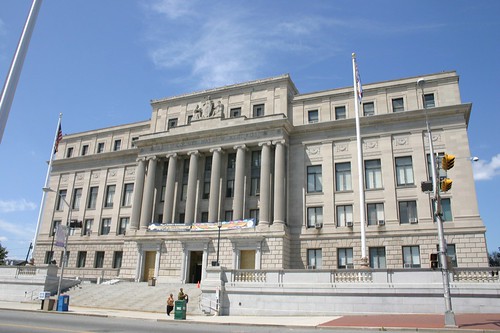
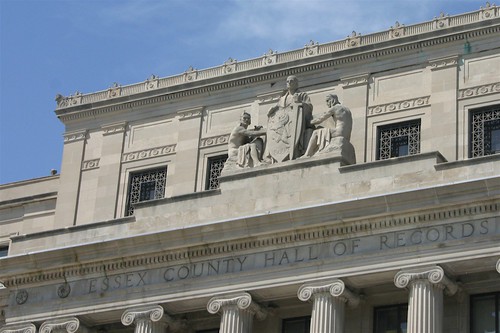
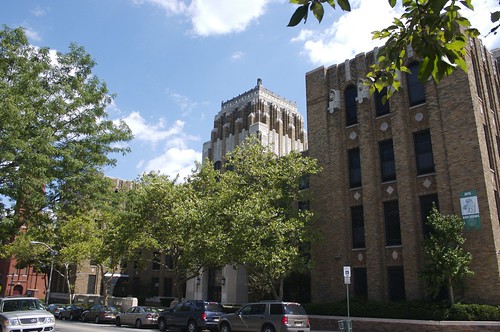
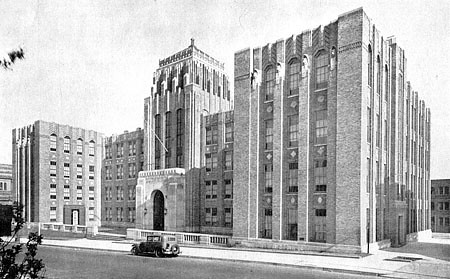

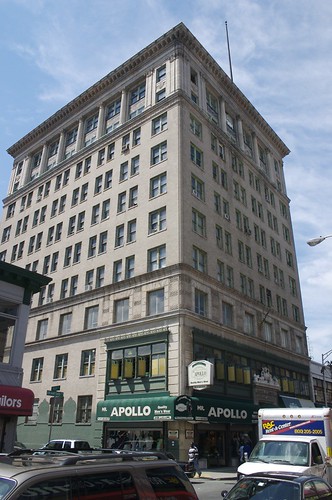
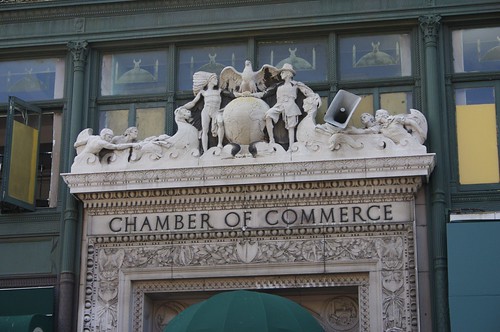

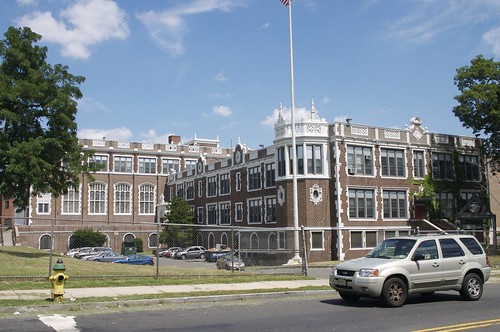
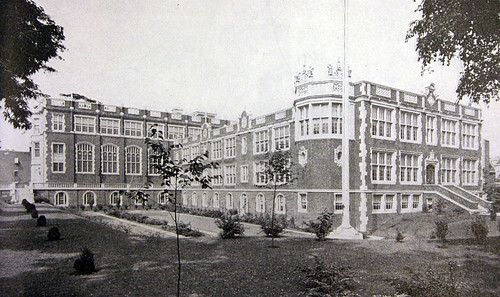
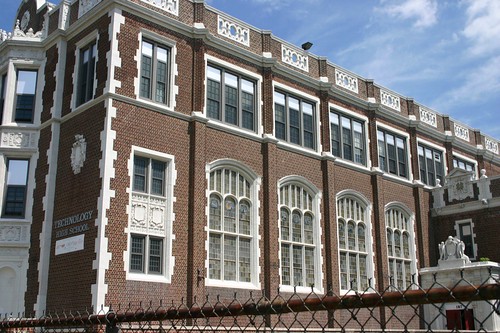
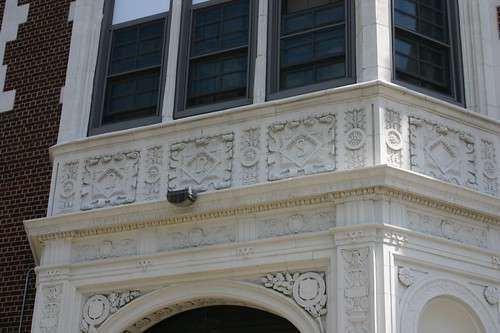
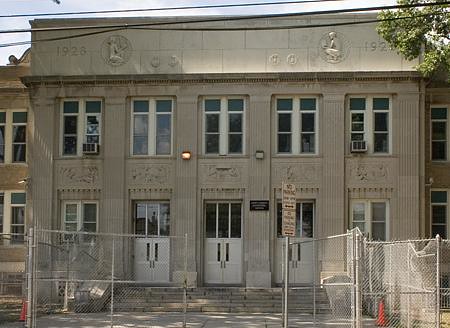
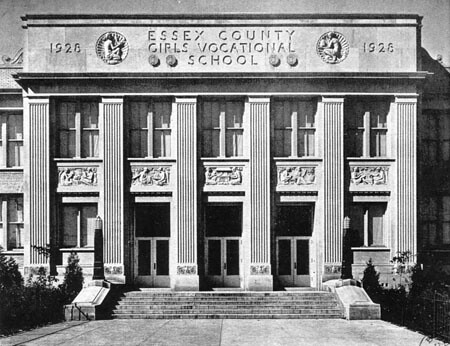
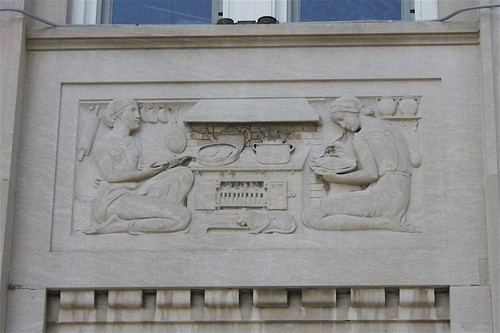
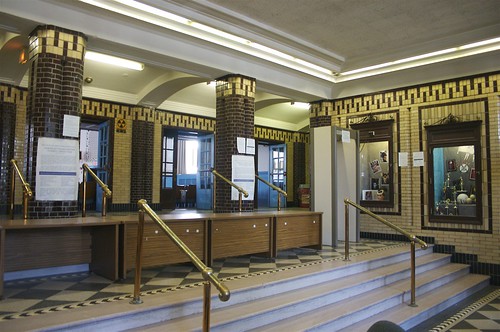
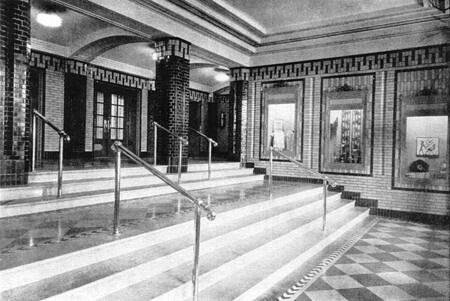
wow, excellent work !
I lived in Newark many years, in fact taught at NSFIA, but I never quite saw it in this light. Thank you, I will definitely pass this link to my friends in Newark who are active in historic preservation.
Compliments !
Drew Knapp
( Colleen Thornton’s friend )
i ran into your intersting architectural tour of Newark while doing research for a massive work, the architectural sculpture in America. I know that Charles Keck did the Hall of Deeds work, but do you have any information about any of the other Guilbert & Betelle projects you visited, or anything else about the subject for that matter. Life is supposed to be interesting. Einar
Einar- The only other sculptural reference I have is for the Chamber of Commerce building, from a copy of Stone Magazine from 1924. The model was also by Keck. The photo in the above article shows the sculpture, over the door.
Here is the photo from Stone: http://flickr.com/photos/sweintraub/463635431/
So I wondr if Keck did the Essex Co Girls’ School too? That work sort of reminds me of another Keck, in Scranton PA that is the insdie of a coal miner’s home – with a pet dog instead of cat, but similar. Thanks for the STONE picture, and if you have other tips about architectural sculpture I am definately up for them.
Dunno, but I do love those relief panels. Sadly they are all but ignored now.
I was an instuctor at the Newark School In the early 60’s and 70’s. It was always a majestic building. The sculpture room was in the sub basement and it had many little nooks that just wanted to be explored. Wonderful memories, beautiful murals and architecture.
David J.Rush 1964-1972
I am current student attending Lehigh University, and it is sad as a resident of Newark , that it suffers such a bad stereotype despite it’s potential.
As well attended Saint benedict’s prep which is down the block form the Art’s high building shown in the pictures
I see comments above from Einar Einarsson Kvaran. I would like to contact you about your Annotated Inventory of Outdoor Sculpture in Washtenaw County. I am writing a book of stories told by military chaplains and I’d like to verify material that is said to come from that document about The Four Chaplains. If you see this, please contact me! Thank you.
Oops… corrected the website address.